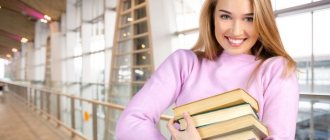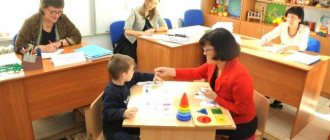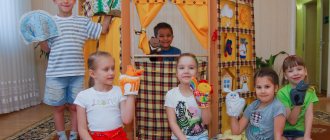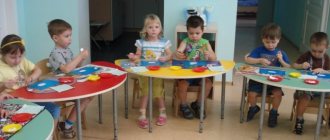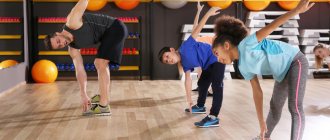"Childhood" program. Main directions of development of a preschool child
Natalia Strebkova
"Childhood" program. Main directions of development of a preschool child
" Program " Childhood "
.
The main directions of development of a preschool child »
Childhood is the summer wind ,
The sail of the sky and the crystal ringing of winter.
Childhood means children,
Childhood means us!
R. Rozhdestvensky
Preschool age is a bright, unique page in the life of every person. It is during this period that the process of socialization begins, the child’s with the leading spheres of existence is established: the world of people, nature, the objective world.
The goal of the program is to create for each child in kindergarten the opportunity to develop abilities , broad interaction with the world, active practice in various types of activities, and creative self-realization. The program is aimed at developing independence , cognitive and communicative activity, social confidence and value orientations that determine the child’s behavior, activities and attitude to the world .
Features of the content of the Childhood program
It is structured in accordance with the current interests of modern preschoolers and is aimed at their interaction with different spheres of culture: visual arts and music, children's literature and their native language, the natural world, the objective and social world. Such broad cultural and educational content becomes the basis for the development of cognitive and creative abilities, to satisfy the individual inclinations and interests of children at different stages of preschool childhood .
Each section of the program provides for the operation of a general mechanism:
There is a fascinating acquaintance of children with objects characteristic of a particular area of culture, the development of cognitive, practical, speech and creative skills in a variety of activities, allowing the child to show independence and creative activity to the best of his individual capabilities, conditions are created for the emotional acceptance by children of relevant moral and aesthetic values. values. As a result, the preschooler acquires the necessary personal sociocultural experience, which becomes the foundation for full development and readiness for school.
Motto of the Childhood Program
“Feel-Cognize-Create”
.
The line of feelings determines the direction of the preschooler’s emotional development in the program the child’s emotionally comfortable state , harmony of interaction with peers and adults, the objective and natural world. The emotional responsiveness of preschoolers is actively developing through exposure to art, music, literature, and folk culture.
Line of knowledge. The goal of the program is to promote the development of cognitive activity, curiosity, the desire for independent knowledge and reflection, the development of mental abilities and speech.
The line of independence and creativity of children. The goal of the program is to enrich the experience of independent activity, awaken children's creative activity, and stimulate their imagination.
Principles “ Childhood ” program
full-fledged life for a child at all stages of childhood
building educational activities based on the individual characteristics of each child .
assistance and cooperation between children and adults.
supporting children's initiative in various activities;
cooperation with family;
introducing children to sociocultural norms, traditions of the family, society and state;
formation of cognitive interests and cognitive actions of the child in various types of activities;
age adequacy of preschool education (compliance of conditions, requirements, methods with age and developmental );
taking into account the ethnocultural situation of children's development .
The life of a child of the 21st century has changed very much and is closely connected with the capabilities of his parents. He can master a mobile phone and computer, TV and tape recorder faster than an adult. He listens to and watches the same songs and TV shows with his parents; goes with his family to cafes and restaurants, goes abroad on vacation, travels; knowledgeable about car brands and advertising. He is interested in many things and talks about many things.
At the same time, the child is still focused on self-valued, childish activities . He loves to play, compose, fantasize, rejoice and reason.
All these new features of modern preschool childhood are reflected in the Program .
In the updated Program in accordance with the Federal State Educational Standard for preschool education:
The objectives, content and results of educational activities are determined in each age group and in each educational area:
Social and communicative development ,
Cognitive development ,
speech development ,
artistic and aesthetic development ,
Physical development ;
Variable forms, methods, methods and means of implementing the program ; features of educational activities of different types and cultural practices of children; features of the organization of pedagogical diagnostics and monitoring;
the features of interaction between the teaching staff and the families of students are characterized;
the content of teaching materials and training and education tools was determined; traditional events, holidays, events; features of the organization of the developing subject-spatial environment;
At the present stage, “ Childhood ” program
is a single
program and methodological complex , including:
“ Childhood ” program
for children from birth to 7 years;
methodological support for the implementation of the program in preschool educational organizations and in the family;
methodological support for the process of training a teacher ready to implement “ Childhood ” program
.
monitoring of child development and educational process in the context of the implementation of “ Childhood ” program
.
By the age of seven, with successful completion of the Program , the following level of development of the child’s qualities :
— Basic physical qualities
— Independently performs age-appropriate hygiene procedures,
— Interested in new, unknown things in the world around him
— Asks questions to adults, likes to experiment.
- Able to act independently
— Takes a lively, interested part in the educational process.
- Responds to the emotions of loved ones and friends.
- Empathizes with the characters of fairy tales, stories, stories.
— Reacts emotionally to works of fine art
— Adequately uses verbal and non-verbal means of communication, has dialogical speech and constructive ways of interacting with children and adults
- Able to change the style of communication with an adult or peer
— Behavior is primarily determined not by immediate desires and needs, but by demands from adults
— Able to plan his actions aimed at achieving a specific goal.
— Complies with the rules of behavior on the street in public places
- Can apply independently acquired knowledge and methods of activity to solve new problems (problems posed by both adults and himself;
- Able to propose his own idea and translate it into a drawing,
- Has ideas about himself, his own belonging and the belonging of other people to a certain gender;
- Able to work according to rules and patterns, listen to an adult and follow his instructions.
— The child has developed the skills and abilities necessary to carry out various types of children's activities .
- social feelings and moral experiences of pupils are formed;
— increased level of cognitive activity and curiosity;
— the ability to consciously use different methods and techniques of cognition, interest in experimentation, readiness for logical cognition has been formed;
- increased level of speech development ;
— the level of children’s creative activity and creative independence has been increased;
Structure and content of the program
The comprehensive program “Childhood” is aimed at creative self-realization and the development of independence in preschool children.
The structure of the Program is represented by the following educational areas:
- Cognitive development
- Social and communicative development
- Physical development
- Speech development
- Artistic and aesthetic development
The main goal of the Program is to create optimal conditions that provide each kindergarten student with the opportunity to fully interact with the outside world through various types of activities.
Are you an expert in this subject area? We invite you to become the author of the Directory Working Conditions
The content of the Program in accordance with the Federal State Educational Standard for Education assumes:
- The presence of three sections: target, content and organizational.
- Having an idea about the peculiarities of organizing the educational process in different age groups.
- Characteristics of the developmental characteristics of preschool children and the expected results of mastering the Program in different age groups.
- Setting objectives and expected results of mastering the Program, and on their basis filling out the content for each educational area in each age group.
- Disclosure of the features of play and play activity as a special developmental space for a preschool child.
- Description of variable forms, methods, means and means of effective implementation of the Program.
- Description of the features of educational and other activities of children, depending on their age.
- Main directions and ways to support children's initiative.
- Features of the organization of pedagogical monitoring and diagnostics.
- The characteristics of the interaction between the teaching staff and the student’s family are given.
- The necessary methodological recommendations for designing the main educational program of a preschool educational institution are presented.
- The content of teaching materials, as well as the basic methods and means of education and training, are determined.
- The daily routine for each age group is presented, as well as the daily routine for the period of children’s adaptation to the conditions of the preschool educational institution.
- The features of conducting traditional preschool educational activities and the features of organizing the subject-developmental environment of the group are revealed.
- The Programs Appendix contains sample partial educational programs.
Finished works on a similar topic
Course work Comprehensive program “Childhood” 430 ₽ Essay Comprehensive program “Childhood” 260 ₽ Examination Comprehensive program “Childhood” 230 ₽
Receive completed work or specialist advice on your educational project Find out the cost
The principles on which the Program is implemented:
- Principle of education and development
- The principle of preserving and strengthening the health of pupils
- The principle of cooperation with the student’s family
- The principle of introducing children to social and cultural principles
- The principle of relying on the traditions of family, society and state
Features of the Program content
The main feature of the Program is that its content is person-oriented and aimed at developing a humane attitude in children towards the world around them.
The program is aimed at meeting the most pressing needs of modern preschoolers, through their interaction with different spheres of culture (fine arts, music, native language, etc.). It is this extensive and varied content of the Program that is the basis for the full and comprehensive development of children’s creative and cognitive abilities, their natural inclinations and interests at all stages of preschool childhood.
Each section of the Program involves the operation of one general mechanism:
- Introducing children to a specific cultural area or object.
- Children's fascination with a given area or object.
- Each student masters the necessary skills and abilities that allow self-realization in a given cultural area and satisfy their own individual needs.
- Children demonstrate independent creative activity through acquired skills and abilities.
- Creating the necessary conditions for children’s emotional acceptance of aesthetic and moral values.
Note 1
Thus, each pupil receives his own sociocultural experience, which becomes the foundation for the further full development of the child and his readiness for schooling.
